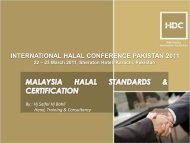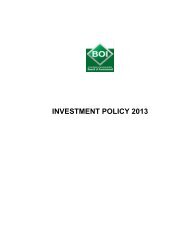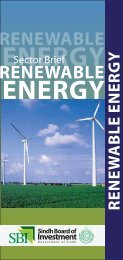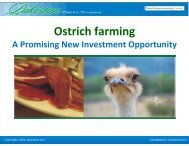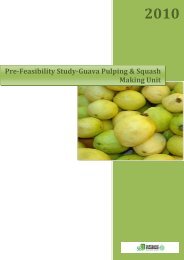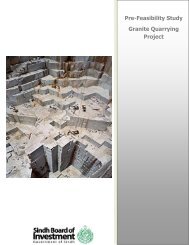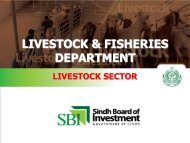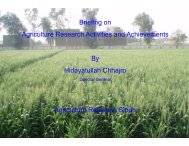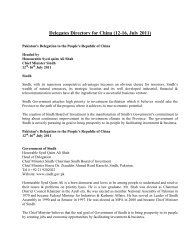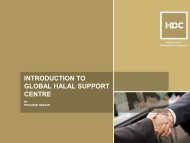2. Pre-Feasibility Study for Environmentally Controlled Poultry House
2. Pre-Feasibility Study for Environmentally Controlled Poultry House
2. Pre-Feasibility Study for Environmentally Controlled Poultry House
Create successful ePaper yourself
Turn your PDF publications into a flip-book with our unique Google optimized e-Paper software.
<strong>Pre</strong>-<strong>Feasibility</strong> <strong>Study</strong><strong>Environmentally</strong> <strong>Controlled</strong><strong>Poultry</strong> <strong>House</strong>(30,000 Birds)
PRE-FEASIBILITY, CONTROLLED POULTRY HOUSE OF 30,000 BIRDS 2010Table of ContentsEXECUTIVE SUMMARY ........................................................................................................................................................................................ 31. OVERVIEW OF THE POULTRY SECTOR ................................................................................................................................................ 41.1. Industry Dynamics ................................................................................................................................................................................. 41.1.1. Segmentation ........................................................................................................................................................................................................... 51.<strong>2.</strong> Marketing Analysis ................................................................................................................................................................................ 51.3. Problems with <strong>Poultry</strong> in Pakistan ...................................................................................................................................................... 6<strong>2.</strong> PRE-FEASIBILITY STUDY FOR ENVIRONMENTALLY CONTROLLED POULTRY HOUSE ....................................................... 8<strong>2.</strong>1. Comparative Efficiency of ECH and COH ......................................................................................................................................... 8<strong>2.</strong><strong>2.</strong> Existing Marketing Practice & Pricing ................................................................................................................................................. 9<strong>2.</strong>3. Farm Management ............................................................................................................................................................................... 103. THE PROJECT .............................................................................................................................................................................................. 133.1. Project Brief ........................................................................................................................................................................................... 133.<strong>2.</strong> Proposed Capacity ............................................................................................................................................................................... 133.3. The Product ........................................................................................................................................................................................... 133.4. Product Assumptions .......................................................................................................................................................................... 143.5. Manpower Requirements .................................................................................................................................................................... 153.6. Farm Equipment ................................................................................................................................................................................... 163.7. Land and Building ............................................................................................................................................................................... 173.7.1. Mode <strong>for</strong> Acquiring Land ........................................................................................................................................................................................ 173.7.<strong>2.</strong> <strong>Pre</strong>ferred Locations – Sindh ................................................................................................................................................................................... 183.7.3. Infrastructure Requirement ................................................................................................................................................................................... 183.8. Working Capital ................................................................................................................................................................................... 184. THE FINANCIAL ANALYSIS ..................................................................................................................................................................... 194.1. Project Economics................................................................................................................................................................................. 194.<strong>2.</strong> Financing Option .................................................................................................................................................................................. 204.3. Projected Income Statement ................................................................................................................................................................ 214.4. Projected Cash Flow Statement .......................................................................................................................................................... 225.5. Projected Balance Sheet ....................................................................................................................................................................... 23KEY ASSUMPTIONS .............................................................................................................................................................................................. 24ANNEX A .................................................................................................................................................................................................................. 27ANNEX B .................................................................................................................................................................................................................. 28ANNEX C .................................................................................................................................................................................................................. 29IMPORTANT CONTACTS .................................................................................................................................................................................... 302
PRE-FEASIBILITY, CONTROLLED POULTRY HOUSE OF 30,000 BIRDS 2010Executive SummaryThis <strong>Pre</strong>-feasibility study is conducted <strong>for</strong> establishment of <strong>Environmentally</strong> <strong>Controlled</strong> <strong>Poultry</strong> Farm inSindh. All the calculations have been based on a flock size of 30,000 birds, with raising 8 flocks per year.The controlled poultry farm is a project of Livestock Sector, in which, the day old chicks (also known asDOCs) are raised on high protein feed <strong>for</strong> a period of six weeks with a lag time of 10 – 15 days <strong>for</strong> thecleaning and fumigation of the sheds and the farm. The purpose of the controlled poultry farm is to provideall the facilities ranging from automatic operations of temperature control, feeding and nipple drinkingsystem <strong>for</strong> the broiler birds, monitored by the concerned & technical staff, all in-house. Broiler farming incontrolled environment is a profitable venture due to continuous increasing demand of the white meat inthe market. <strong>Poultry</strong> is an important sub – sector of agriculture and has contributed enormously to foodproduction by playing a vital role in the domestic economy. <strong>Poultry</strong> meat contributes 19% of the total meatproduction in the country. There is a tremendous opportunity <strong>for</strong> Environmental Control <strong>Poultry</strong> <strong>House</strong>s inPakistan. Currently there are 2,500 houses working in Pakistan, out of which 75% (1,875) are in Punjab andremaining 25% (625) are in other provinces 1 .The initial cost of the project is Rs. 29,596,720, including of an initial working capital of Rs. 5,774,720.1. Projected Revenues <strong>for</strong> the project <strong>for</strong> year 1, year 2, year 3, year 4 and year 5 is Rs. 53,194,080, Rs.58,513,488, Rs. 64,364,837, Rs. 70,801,320 and Rs. 77,881,453, respectively.<strong>2.</strong> Gross profit / (loss) <strong>for</strong> year 1, year 2, year 3, year 4 and year 5 is Rs. 9,880,800, Rs. 11,556,336, Rs.13,435,454, Rs. 15,540,431 & Rs. 17,895,872, respectively.3. Payback period of the project is approximately 3.5 years.4. The IRR of the project is 21.52%.1 Source: Environmental <strong>Controlled</strong> <strong>Poultry</strong> Farm, SMEDA, April 20103
PRE-FEASIBILITY, CONTROLLED POULTRY HOUSE OF 30,000 BIRDS 20101. Overview of the <strong>Poultry</strong> Sector<strong>Poultry</strong> is an important sub – sector of agriculture and has contributed enormously to food production byplaying a vital role in the domestic economy. It has great potential and can play a significant role in thenational economy by contributing towards food security of the country, reducing pressure on demand <strong>for</strong>mutton and beef and earning of <strong>for</strong>eign exchange. <strong>Poultry</strong> industry can broadly be divided into three groups,viz. hatchery, poultry farming and feed sectors. This sector generates employment and income <strong>for</strong> about 1.5million people in Pakistan. Its contribution in agriculture growth is 4.81% and in Livestock growth is 9.84%,whereas, the total poultry meat contributes to 23.8% of the total meat production in the country.Pakistan, with a population of 170 Million people, has gone through a sizeable growth in the production ofpoultry meat and eggs. Per capita availability went up from 23 in 1991 to 46 eggs in 2009 and poultry meatavailability increased from 1.48kg to <strong>2.</strong>88 kg during the same period 2 . In our Country per capita consumptionof meat is only 7 KG and 60-65 eggs annually. Whereas developed world is consuming 41 KG meat and over300 Eggs per capita per year. According to Industry sources there is capacity of 5,000 Environmental Control<strong>House</strong>s in Pakistan and currently only 2,500 houses are working.1.1. Industry DynamicsThe generation line of broiler comes from pure line (Strains) that make the Great Grand Parents (GGP),which are imported. These great grandparents produce grandparents which are available in Pakistan. Thesegrandparents produce parent stocks (Breeders) and parent stock end up in producing the final productwhich is broiler. Pakistan’s poultry industry is importing 100,000 Grandparents (GP) chicks annually fromAustralia, Holland, Germany and USA with the cost of US$100 per day-old female chick. The farmers get dayold broiler from hatcheries. These hatcheries maintain their breeder farms, or in some cases, purchase theirhatching eggs from breeder farms. These breeder farms depend on producers of parent stock.<strong>Poultry</strong> feed mills are the major player in the poultry industry, which produce a specific <strong>for</strong>mula feed mix.<strong>Poultry</strong> feed consists of rich protein elements like soya bean meal, canola meal, rapeseed meal, sunflowermeal, feather meal and rich energy elements like grains, gluten, etc. When feed efficiency matters most youcan gain the right weight of your bird. The major component of cost of production of chicken meat accounts<strong>for</strong> feed cost.2 FAOSTAT (2009)4
PKR MillionPRE-FEASIBILITY, CONTROLLED POULTRY HOUSE OF 30,000 BIRDS 20101.1.1. Segmentation 3Total InvestmentRs. 200 BillionNo. of Hatcheries 400No of Feed Mills 150Grand Parents 200,000Parents6 MillionBroiler600 Million<strong>Poultry</strong> Meat621,000 Metric Ton1.<strong>2.</strong> Marketing AnalysisThe total <strong>Poultry</strong> population in Pakistan is approximately 610 Million. The chart below illustrates theincrease in the number of poultry population over the years 4 .Figure 1: Increase in the number of <strong>Poultry</strong> population in Pakistan (2000 - 2010)Similarly, there has been a substantial increase in the Livestock products pertaining to <strong>Poultry</strong> i.e. <strong>Poultry</strong>meat and and Eggs 3 .3 Source: Environmental <strong>Controlled</strong> <strong>Poultry</strong> Farm, SMEDA, April 20104 Source: Economic Survey of Pakistan 2010 – 20115
PRE-FEASIBILITY, CONTROLLED POULTRY HOUSE OF 30,000 BIRDS 2010Figure 2: Increase in the number of <strong>Poultry</strong> Eggs & Meat in Pakistan (2000 - 2010)According to FAO, to produce chicken meat in 2008, 517 million birds were slaughtered and 601 milliontonne meat was acquired. In the same year world total chicken meat production was 52,887 million ton.There are around 25,000 poultry farms are in the country 5 . The poultry production is concentrated aroundthe large urban centres in the provinces of Sindh especially in Karachi. In the provinces of Sindh, there arefarms in Mirpurkhas, Sukkar, Nawabshah as well as in small cities. Many big companies have establishedtheir poultry farms in different parts of the country. To name a few such key players are K&N, Sabir, Hitech,SB and Jadeed.1.3. Problems with <strong>Poultry</strong> in PakistanA balanced diet is essential <strong>for</strong> good health, vigour and productive capacity of the people. Proteins play animportant role in the <strong>for</strong>mation of balanced human diet. There are mainly two sources of proteins i.e.animals and plants. The human diet in Pakistan is deficient in animal proteins, as approximately 66%Pakistanis are deficient in proteins. The requirement of proteins is 10<strong>2.</strong>7 g per person per day, while only69.61 g per person per day is being used in the country.The main sources of animal proteins in Pakistan are beef, mutton, milk, poultry meat and eggs. To overcomethe gap between supply and demand of proteins, poultry meat is contributing a dominant share which canbe enhanced by improving the profitability of producers and by decreasing prices at the retail level. Theprofitability can be increased through better management practices and establishment of fully equippedcontrolled poultry houses.5 Source: Pakistan <strong>Poultry</strong> Association (www.ppapaknorthern.com)6
PRE-FEASIBILITY, CONTROLLED POULTRY HOUSE OF 30,000 BIRDS 2010Pakistan, being a tropical country, experience various temperatures throughout the year of which summer isthe most common. During this period the temperature reaches over 40°C in different parts of Pakistan. Thisaffects the efficiency of the poultry farms and the chickens. Hot and humid weather conditions coupled withmanual and poor management practices increases the mortality in flocks, depresses their growth and makespoultry production an unmanageable and uneconomical pursuit. Chickens can tolerate high temperaturesbut react negatively if they are too warm. The body temperature of an adult chicken is 105-107°F (40.6 to41.7°C). The thermo-neutral zone is 65-75°F (18-24°C), which allows chickens to maintain their bodytemperature. If the temperature is above this zone, heat must be lost in some way. Chickens have no sweatglands. Since eating increases body temperature, chickens reduce their feed intake during hot weather, andthere<strong>for</strong>e gains will be less. Chickens begin panting at 85°F (29.4°C) to help dissipate heat, and drink more toavoid dehydration. A combination of high temperature and high humidity is a problem, because pantingdoes not cool them under these conditions. During this period owner has to either continue his flockcompromising with poor per<strong>for</strong>mance in feed intake, growth rate, weight gain, FCR (Feed Conversion Ratio)in broilers along with mortality or he has to totally close his business to avoid all these risks. This situationcreates severe shortage of poultry meat which is the cheapest and easily available source of animal protein.The poultry industry also faces problems like the incidence of diseases, substandard and costly feed andinefficient marketing system. In all stages of development, there is a need <strong>for</strong> improving the efficiency andlowering the cost of distribution.Losses occur in case of death of birds due to diseases and poor handling. Grading is largely ignored in eggtrade because of extra cost required <strong>for</strong> grading. Inadequate health facilities are one of the majorconstraints in poultry production. It is due to viral, bacterial infection and parasitic infestation.Environment controlled houses can overcome such critical situations, which counteracts the adverse effectsof heat stress providing tunnel ventilation and enhancing the wind chill effect. These houses when equippedwith highly mechanized system of automatic chain feeding and nipple drinking makes the environment quiteconducive <strong>for</strong> poultry production and reduces the risk of bacteria during different seasons.7
PRE-FEASIBILITY, CONTROLLED POULTRY HOUSE OF 30,000 BIRDS 2010<strong>2.</strong> <strong>Pre</strong>-<strong>Feasibility</strong> <strong>Study</strong> <strong>for</strong> <strong>Environmentally</strong> <strong>Controlled</strong> <strong>Poultry</strong> <strong>House</strong><strong>2.</strong>1. Comparative Efficiency of ECH and COHThe modern trend of environment control houses (ECH) in poultry production has brought a great revolutionin poultry industry of Pakistan in the recent years. This has solved a great hurdle of heat stress in the wayeconomical commercial poultry production. The ECH with evaporative cooling system, providing tunnelventilation, giving the wind chill effect has markedly improved the broiler production system. Thetechnology of ECH is rapidly becoming popular among broiler producers. A comparison is given below of ECHand a traditional house which highlights significant advantages of an ECH are given below:No Specification Control <strong>House</strong> Traditional <strong>House</strong>1 Feed Conversion Ratio 1.9 – <strong>2.</strong>3 <strong>2.</strong> 52 Feed wastage Nil 10 %3 Feed distribution Automatic Laborious4 Body Wt / bird 42 days 1.9 Kg 1.65 Kg5 Humidity of shed <strong>Controlled</strong> High6 Brooding Energy saving Energy wastage7 Carbon mono oxide poisoning Nil Very high8 Ammonia poisoning Nil Very high9 Mortality 5 – 8 % 10 – 30 %10 Electricity Required No required11 Rodent Control Successful Failed12 Wild protection No risks High risky13 Bio-security measure Very easy Very difficult14 Noise stress Nil Very high15 Environmental Stress Nil Very high16 Mortality due to heat stress Nil 20-100 %17 Over head / bird Rs.10.00 Rs.8.008
PRE-FEASIBILITY, CONTROLLED POULTRY HOUSE OF 30,000 BIRDS 201018 Dosage of vaccine & medicine Accurate Wastage19 Medication & vaccination application Appropriate Difficult20 Litter humidity Under control Not control able21 Flock Sizing One size Multiple size22 Shed temperature Automatic Big variation23 Expenditure of maintenance energy Accurate Wastage24 <strong>Poultry</strong> environment (neighboring) Health Contaminated25 Fly control Successful Not possible26 Feed and water intake Recordable No recordable27 Light intensity <strong>Controlled</strong> Not control able28 Feed storage environment Appropriate Humid29 Flock monitoring Computerized ErrorAll these significant features in ECH have reduced the cost of production of broiler to Rs. 7 to 8 Per Bird ascompared to COH.<strong>2.</strong><strong>2.</strong> Existing Marketing Practice & PricingThe Broilers are distributed in the market through Middleman and Whole seller. Broilers are transported tothe urban market and are sold on live-weight basis. The current pricing of the broilers and other poultryproducts are mentioned below 6 :ProductPKR Rs.Chicken Meat per KG 170 – 200Chicken (Live) 120 – 145Eggs per Dozen 55 – 75Day Old Chick Broiler 50 – 65Day Old Chick Layer 60 – 706 Source: Pakistan <strong>Poultry</strong> Association (www.ppapaknorthern.com). There is an increase of 25% from what is mentioned on the PPA Website asthose rates are pertaining to the Punjab Province whereas in Sindh the rates are high.9
PRE-FEASIBILITY, CONTROLLED POULTRY HOUSE OF 30,000 BIRDS 2010During the years 2008-09 and 2009-10 sharp fluctuations occurred in the prices of day old chicks. The datamade available by <strong>Poultry</strong> Research Institute shows price of day old broiler and layer chick was Rs 11 and Rs35.5 respectively in January 2008. The lowest price during the period <strong>for</strong> broiler and layer day old chick wasRs. 6 and Rs. 28 respectively and the highest price was Rs 71.9 and Rs 39 in October 2009. On the basis ofin<strong>for</strong>mation provided by <strong>Poultry</strong> Research Institute and by leading companies of poultry industry to the CCPthe cost of production of day old broiler chick was around Rs 18 per chick. The chick was being sold belowcost during almost all months of the year 2008 and since January 2009 the prices rapidly increased andtouched the figure of Rs 71.9, leading towards proportional increase in the prices of poultry meat, since theprice of day old broiler chick are directly related to price of poultry meat. The current price of DOC’s rangefrom Rs. 50 – Rs. 65 whereas DOC layer costs Rs. 60 – Rs. 70.The prices of poultry feed also showed a consistent increase during the years of 2008 to 2010. The averageprice of a bag of 50 kg poultry feed had been Rs. 955 during year 2008, which rose to Rs. 1,450 in 2010. Oneof the factors of increase in the prices of day old chicks and poultry meat is the increase in prices of feed thatis one of the basic inputs in poultry industry.<strong>2.</strong>3. Farm ManagementFarm input required <strong>for</strong> a broiler farm includes farm equipment (Automatic feeding system, water nipplesystem, exhaust fans, cooling pads, diesel heaters, control panels and other consumable items (feed,vaccines, medicines, rice husk, water, electricity etc.). The figure below illustrates what the farm will looklike once constructed and ready <strong>for</strong> flock raising.10
PRE-FEASIBILITY, CONTROLLED POULTRY HOUSE OF 30,000 BIRDS 2010Below are features of the <strong>Environmentally</strong> <strong>Controlled</strong> <strong>Poultry</strong> <strong>House</strong>:Day Old ChicksThe Chicks should be uni<strong>for</strong>m size, alert and bright eyed. The shank or leg covering (skin) of health chicksappears bright and shiny.BroodingProper brooding temperature is required to keep the chicks in com<strong>for</strong>t. Diesel heaters supply heat at thestage of brooding in the <strong>Poultry</strong> Farm. In the first week 32 ‘C is quite com<strong>for</strong>table. As chicks grow, thetemperature may be reduced at the rate of 2 ’C per week until 24 ‘C reached in last week.FeedingBroilers re usually feed with following two types of broiler starter. It is feed to the broiler up to 5 weeks ofage. Secondly, is the Broiler Finisher which is feed to the Broiler of more than 5 weeks and continued till theage of marketing.HousingThe Broiler control house size 400 feet long and 50 feet side is enough <strong>for</strong> 30,000 birds.FeedersThe pan feeders of automatic feeding system are <strong>for</strong> 65-70 birds. There<strong>for</strong>e, 465 feeders in a house areenough <strong>for</strong> 30,000.LightingThe control house broiler grows on artificial light (not the sunlight). One house 20,000 sq feet requires 100energy saver of 9 watts each i.e. 900 watts.Automatic feeding systemThe nipple is enough <strong>for</strong> 12-15 birds. In 30,000 broilers house total nipples required are 2500 there areautomatic water system, whenever bird touches the nipple water flows out and when bird will away nowater is there.LitterLitter is spread on the floor. Rice husk is usually <strong>for</strong> the making the litter. It should be dry and free of mould.Caked or mould material should be removed and refilled with fresh materials. Extensively wet and dustylitter should be also not be used. Using new litter <strong>for</strong> each flock is good <strong>for</strong> raising disease free broiler.11
PRE-FEASIBILITY, CONTROLLED POULTRY HOUSE OF 30,000 BIRDS 2010VaccinationVaccination can be provided through spray and drinking water.DisinfectionIt is essential to check all equipment and walls of the broiler house carefully that they are clean and washedwith detergents, disinfectants. The house should be fumigated be<strong>for</strong>e the birds.12
PRE-FEASIBILITY, CONTROLLED POULTRY HOUSE OF 30,000 BIRDS 20103. The Project3.1. Project BriefThe Broiler Control <strong>House</strong> is a project of Livestock sector, in which day old chicks (DCO’s) are raised on highprotein feed <strong>for</strong> a period of six weeks.This pre-feasibility highlights the capacity and efficiency of Broiler Control <strong>House</strong> which covers all therequired facilities <strong>for</strong> the fast growing broilers. Annually eight flocks of birds will be raised on the samepremises of the farm.3.<strong>2.</strong> Proposed CapacityA Broiler farm of about 30,000 birds is considered to be economically viable size, which will justify the fixedand operational costs. In this pre-feasibility study, all calculations have been based on a flock size of 30,000birds with raising seven flocks per year. An additional lag time of 10 days will be included <strong>for</strong> the cleaningand disinfection of the farm/house.3.3. The ProductThe proposed project should generate revenues from sale of chicken after they have been raised <strong>for</strong> 6-7weeks in the <strong>Environmentally</strong> <strong>Controlled</strong> <strong>Poultry</strong> Shed. Assumptions used <strong>for</strong> the product mix are as follows:Product Average Weight PriceChicken 1.90 Kg 228Hence, the cost of Price per Kg is 228/1.9 = Rs. 120. 77 This price is taken as the current average market rate (2010). Source: Pakistan <strong>Poultry</strong> Association (www.ppapaknorthern.com)13
PRE-FEASIBILITY, CONTROLLED POULTRY HOUSE OF 30,000 BIRDS 20103.4. Product Assumptions 8Number of Flocks per year 8Number of Birds per Flock 30,600Time required per Flock (Days) 35Lag time required per Flock (Days) 10Total Annual Production Capacity 244,800Shed Space Required per Bird (Sq.ft) 0.65Mortality Rate 5%Average Rate per bird1.9 KgBroiler Sale price per Kg (Live) Rs. 120Sale price growth rate 10%Cost of 50 Kg Feed bag Rs. 1,600Cost of Feed per Kg bag Rs. 328 Analysis attached in Annexure A14
PRE-FEASIBILITY, CONTROLLED POULTRY HOUSE OF 30,000 BIRDS 20103.5. Manpower RequirementsSkilled and Semi skilled workers are needed to manage the operation of a broiler farm of 30,000 birds. Theseworkers will look after the feeding, vaccination and cleaning operations at the farm. The personal needed <strong>for</strong>the farm is as under:Description Required Personal Salary Per Month Salary <strong>for</strong> the YearSupervisor 1 24,000 288,000Doctor 1 12,000 144,000<strong>House</strong>men 3 6,500 234,000Electrician 1 10,000 120,000Watchmen 2 7,500 180,000Cleaner 3 6,000 216,000Total 11 98,500 1,182,00015
PRE-FEASIBILITY, CONTROLLED POULTRY HOUSE OF 30,000 BIRDS 20103.6. Farm EquipmentIn order to make sure the birds are being fed properly and in a timely manner the following farmequipments and technology have been identified. This technology <strong>for</strong> feeding, drinking and handling of birdsis most suitable <strong>for</strong> a high tech. <strong>Controlled</strong> poultry house. A full illustration is provided in Annexure CDescriptionAmount PKRFlux Pan feeding, Tope screw nipple drinkingsystem with BD sile (one house) 9 2,300,000Exhaust fan with 1 NP Motor type EOS50 1.06 Alu(13 required at Rs. 60,000 each)780,000Evaporative cooling pads (91 required at Rs. 6,000each)546,000Heater type combi term 140E (1 required) 420,000Minimum ventilation system (1 required) 680,000Electrical control panel (1 required) 250,000Generator 50 – KVA (Perkins 1104A-44TG1) 950,000Cost of Uni<strong>for</strong>ms, shoes, bio-security equipments& other miscellaneous expenses 10 750,000Installation cost 250,000Total 6,926,0009 Rates have been taken from Cumberland <strong>Poultry</strong> Services: http://www.cumberlandpoultry.com/10 Equipments (Drinkers & Feeders <strong>for</strong> chicks) and trays, heaters, fire extinguishers etc.16
PRE-FEASIBILITY, CONTROLLED POULTRY HOUSE OF 30,000 BIRDS 20103.7. Land and BuildingDescription Area (Sq.ft.) Cost TotalLand 1 Acre 1,000,000 1,000,000Description Area (Sq.ft.) Cost (Rs. / Sq.ft.) TotalShed Space (400x50’) 20,000 600 12,000,000Feed Store (30x30’) 1,000 800 800,00Room <strong>for</strong> Guards & Workers 1,200 1,000 1,200,000Office Block 11 1,200 1,100 1,320,000Store Room 250 800 200,000Generator Room 200 400 80,000Water Container 1,000 Gallon 20,000Boundary Wall (6 Feet High) 500,000Total 16,640,0003.7.1. Mode <strong>for</strong> Acquiring LandIt is assumed that the land available will be on a lease (on a subsidised rate) in the locations mentionedbelow.11 Includes changing room17
PRE-FEASIBILITY, CONTROLLED POULTRY HOUSE OF 30,000 BIRDS 20103.7.<strong>2.</strong> <strong>Pre</strong>ferred Locations – SindhSuburban and rural areas around the major cities of the country are the suitable areas <strong>for</strong> setting up apoultry farm. Setting up a farm at an isolated place will minimize the risk of disease. Proximity of the farm tothe city enables the farmer to have a quick communication with the market <strong>for</strong> the purchase of Day OldChicks, farm inputs (feed, etc.), and selling of mature birds. Hence, areas like Gharo, Dhabeji, Bhambhore,Karachi and Hyderabad are identified as a prime location <strong>for</strong> this project.3.7.3. Infrastructure Requirement<strong>Poultry</strong>'s farming needs to be handled tactically, right from the selection of the site to the final stage whenthe birds are sold. The farm should be located at a place where transportation of birds and feed can behandled easily. The entrepreneur should make sure that the following things are available at the farm sitebe<strong>for</strong>e setting up the farm: Electricity connection & drinking quality water.3.8. Working CapitalDescription Rate in Rs. Total AmountCost of Day Old Chicks(Broilers 30,600)52 1,591,200Feed <strong>for</strong> 1 st flock of birds 110 per bird <strong>for</strong> 35days to gain onaverage 1.9 Kg - 2Kg weight3,305,020Salaries (For one month) 98,500Cash 878,500Total 5,774,72018
PRE-FEASIBILITY, CONTROLLED POULTRY HOUSE OF 30,000 BIRDS 20104. The Financial Analysis4.1. Project EconomicsCapital InvestmentAmount in PKRLand 1,000,000Building/Infrastructure 15,640,000Machinery & Equipment 6,926,000Furniture & fixtures 250,000Total Capital Costs 23,816,000Working CapitalAmount in PKRInventory & Expenses** 4,896,220Cash in Hand 878,500Total Working Capital 5,774,720**Inventory & Expenses include salary <strong>for</strong> one month, raw material i.e. fodder, one flock of birds, utilities, transport and fuel expensesTotal Investment PKR 29,590,720An <strong>Environmentally</strong> <strong>Controlled</strong> <strong>Poultry</strong> <strong>House</strong> with a population of 30,000 birds established in a purposebuiltcontrolled shed needs a capital investment estimated at Rs. 23,816,000 <strong>for</strong> construction and purchasingmachinery & equipment. In addition to this, a sum of Rs. 5,774,720 is required as initial working capital,which should be used <strong>for</strong> purchasing day old chicks and other inputs like feed, vaccines, etc and one month’ssalary of the staff. The total project cost is estimated at Rs. 29,590,720.19
PRE-FEASIBILITY, CONTROLLED POULTRY HOUSE OF 30,000 BIRDS 20104.<strong>2.</strong> Financing OptionLooking at the current market trends lending of up to 50% could be available on these projects. A list offinancial institutions willing to facilitate such projects in given in Annexure B. The bank will charge a rate ofat least 20% on financing per annum plus this need to be backed by 200% collateral.Initial FinancingAmount in PKRDebt 50% 14,795,360Equity 50% 14,795,3604.<strong>2.</strong>1. Debt AssumptionsDebt Tenure5 YearsInterest Rate on Long Term Debt 20%Debt PaymentsQuarterly20
4.3. Projected Income StatementRevenue from Sales (Birds &Empty Feed Bags)Statement Summaries EC <strong>Poultry</strong> <strong>House</strong> - SBIProjected Income StatementYear 1 Year 2 Year 3 Year 4 Year 553,194,080 58,513,488 64,364,837 70,801,320 77,881,453Cost of DOCs (12,093,120) (12,697,776) (13,332,665) (13,999,298) (14,699,263)Cost of Feed per annum (26,440,160) (29,084,176) (31,992,594) (35,191,853) (38,711,038)Cost of other goods(vaccination, electricity, diesel,spray etc)(4,780,000) (5,175,200) (5,604,124) (6,069,739) (6,575,279)General administration &selling expensesGross Profit 9,880,800 11,556,336 13,435,454 15,540,431 17,895,872Administration expense (1,182,000) (1,300,200) (1,430,220) (1,573,242) (1,730,566)Communications expense(phone, fax, mail, internet, etc.)Office expenses (stationary,entertainment, janitorialservices, etc.)Professional fees (legal, audit,consultants, etc.)(50,000) (55,000) (60,500) (66,550) (73,205)(45,000) (49,500) (54,450) (59,895) (65,885)(45,000) (49,500) (54,450) (59,895) (65,885)Depreciation expense (2,986,700) (2,986,700) (2,986,700) (2,986,700) (2,986,700)Sub Total (4,308,700) (4,440,900) (4,586,320) (4,746,282) (4,922,240)Operating Profit 5,572,100 7,115,436 8,849,134 10,794,149 12,973,632Less Financial Charges 2,809,907 2,391,408 1,880,884 1,258,133 498,515Net Profit Be<strong>for</strong>e Tax 2,762,193 4,724,028 6,968,250 9,536,016 12,475,117Provision For Income Tax 966,767 1,653,410 2,438,888 3,337,606 4,366,291Net Profit/Loss After Taxes 1,795,425 3,070,618 4,529,363 6,198,411 8,108,826
PRE-FEASIBILITY, CONTROLLED POULTRY HOUSE OF 30,000 BIRDS 20104.4. Projected Cash Flow StatementOperating activitiesCalculations <strong>Poultry</strong> - SBICash Flow StatementYear 0 Year 1 Year 2 Year 3 Year 4 Year 5Net profit - 1,795,425 3,070,618 4,529,363 6,198,411 8,108,826Add: Depreciation expense - 2,986,700 2,986,700 2,986,700 2,986,700 2,986,700Amortization expense - <strong>Pre</strong>operatingcost - - - - -Inventory (4,896,220) (524,538) (576,926) (634,618) (698,080) (767,889)Cash provided byoperations (4,896,220) 4,257,587 5,480,392 6,881,445 8,487,031 10,327,637Financing activitiesChange in long term debt 14,795,360 (1,913,931) (2,333,831) (2,845,852) (3,470,207) (4,231,539)Change in short term debtIssuance of shares 14,795,360 - - - - -Cash provided by / (used<strong>for</strong>) financing activities 29,590,720 (1,913,931) (2,333,831) (2,845,852) (3,470,207) (4,231,539)Investing activitiesCapital expenditure (23,816,000)Cash (used <strong>for</strong>) / providedby investing activities (23,816,000)Net Cash 878,500 2,343,656 3,146,562 4,035,592 5,016,824 6,096,098Cash balance brought<strong>for</strong>ward 878,500 878,500 3,222,156 6,368,718 10,404,310 15,421,134Cash available <strong>for</strong>appropriation 3,222,156 6,368,718 10,404,310 15,421,134 21,517,231Dividend 0 0 0 0 0 0Cash carried <strong>for</strong>ward 878,500 3,222,156 6,368,718 10,404,310 15,421,134 21,517,23122
PRE-FEASIBILITY, CONTROLLED POULTRY HOUSE OF 30,000 BIRDS 20105.5. Projected Balance SheetCurrent AssetProjected Balance SheetYear 0 Year 1 Year 2 Year 3 Year 4 Year 5Cash & Bank 878,500 3,222,156 6,368,718 10,404,310 15,421,134 21,517,231Inventory 4,896,220 5,420,758 5,997,684 6,632,302 7,330,382 8,098,271Total Current Assets 5,774,720 8,642,914 12,366,402 17,036,612 22,751,516 29,615,502Fixed AssetLand 1,000,000 1,000,000 1,000,000 1,000,000 1,000,000 1,000,000Furniture 250,000 212,500 175,000 137,500 100,000 62,500Building/Infrastructure 15,640,000 14,076,000 12,512,000 10,948,000 9,384,000 7,820,000Machinery &Equipment6,926,000 5,540,800 4,155,600 2,770,400 1,385,200 -<strong>Pre</strong>-operating costTotal Fixed Assets 23,816,000 20,829,300 17,842,600 14,855,900 11,869,200 8,882,500Total Assets 29,590,720 29,472,214 30,209,002 31,892,512 34,620,716 38,498,002Liabilities &Shareholders' EquityCurrent liabilities - 1,913,931 2,333,831 2,845,852 3,470,207 4,231,539Accounts payable - - - - - -Total Current Liabilities - 1,913,931 2,333,831 2,845,852 3,470,207 4,231,539Long Term Debt 14,795,360 12,881,429 10,547,598 7,701,746 4,231,539 -Shareholders' EquityPaid-up capital 14,795,360 14,795,360 16,590,785 19,661,403 24,190,766 30,389,176Retained Earnings 1,795,425 3,070,618 4,529,363 6,198,411 8,108,826Total Equity 14,795,360 16,590,785 19,661,403 24,190,766 30,389,176 38,498,002TOTAL CAPITAL ANDLIABILITIES29,590,720 29,472,214 30,209,002 31,892,512 34,620,716 38,498,00223
PRE-FEASIBILITY, CONTROLLED POULTRY HOUSE OF 30,000 BIRDS 2010Key AssumptionsNet Bird Calculation – Flocks/YearTotal birds per flock 30,600No. of birds per flock 30,000Excessive birds @ 2% of Birds 600Mortality in Birds @ 5% of 30,600 = 1,538Net birds after Mortality per flock 29,070Net birds after Mortality <strong>for</strong> theyear232,560Net Bird Calculation – Cost of FeedDescription No. of Birds Amount in PKRTotal Mortal Birds 1,530During first two weeks Mortal birds @ 50% ofTotal MortalityDuring 3rd and 4th weeks Mortal birds @ 30%of Total MortalityDuring 5th and 6th weeks Mortal birds @ 20%of Total MortalityCost of Feed Consumed by Mortal Birds PerFlock765 33,660459 36,720306 37,0001,530 107,320Cost of Feed Consumed by Remaining Birds 29,070 3,197,700Total Cost of Feed Consumed by the Birds PerFlockTotal Cost of Feed Consumed by the Birds PerYear3,305,02026,440,16024
PRE-FEASIBILITY, CONTROLLED POULTRY HOUSE OF 30,000 BIRDS 2010Expenses Assumption – Project Income StatementCommunication expenseOffice expenses (Misc.)Professional fees (legal, audit, consultants, etc.)4% of administration expense4% of administration expense0.08% of revenueDepreciation AssumptionsDepreciation MethodStraight Line MethodBuilding depreciation rate 10%Machinery & Equipment depreciation rate 10%Office Equipment depreciation rate 10%Furniture & Fixtures depreciation rate 15%Cost of Goods AssumptionsDOC (Day Old Chicks) (Rs.) 52Feed Conversion Ratio (FCR) i.e. Feed requiredto gain 1 Kg weight (Kgs.)Vaccination. Medication and Disinfection Costper Bird (Rs.)1.906Feed Price per Bag (50 Kgs) 1,445Cost of Feed per Kg – Rs. 32Price of Empty Feed Bags – Rs. 625
PRE-FEASIBILITY, CONTROLLED POULTRY HOUSE OF 30,000 BIRDS 2010Growth Rate of GoodsSales Growth Rate 10%CGS Growth Rate (DOC, Vaccine & Medication,Litter & Spray)5%Cost of Feed Growth Rate 5%Salaries Growth Rate 10%Electricity & Diesel Growth Rate 10%26
PRE-FEASIBILITY, CONTROLLED POULTRY HOUSE OF 30,000 BIRDS 2010Annex AThe product assumptions are based on real time data derived from useful resources and poultry associations in Pakistan. Abreakdown of the assumptions is explained below:Number of Flocks per yearA flock will contain 30,600 birds i.e. Day Old Chicks, which will be raised 8 times in an year with a raising period of 35 days (45 daysincluding lag time)Number of birds per flockIt is estimated that a flock will contain 30,600 birds as it will be viable to raise them in the ECH proposed location/areaTime required per flock35 days is approximately estimated to raise the birds i.e. one flock (30,000 birds)Lag time required per Flock (Days)10 days are required to clean, paint & fumigate the farm/shed be<strong>for</strong>e the next lot is brought in. With the help of new technologyand machinery the lag time has been brought down to 10 days from 15 days, as conducted in previous studies.Total Annual Production CapacityTotal birds produced in an year will be 30,600 x 8 (flocks per year) = 244,800 – morality rate of 5% = 232,560Shed Space Required per Bird (Sq.ft)Recent survey has indicated that these days Day Old Chicks requires very little space. But as they grow and after 5 weeks offeeding the total space required by a bird would be 0.65 sq. ft. Hence, this figure is taken initially and the construction and areawill be build up according to these details.Sale price growth rateKeeping in view the past trends it would be viable to say that there will be a 10% increase in the sale price of the chicken. Thisincrease keeps in view different factors like quality of chicken, bird weight, other economic factors like inflation, taxes etc.Production capacity utilizationThe plant/shed would be used to its fullest capacity throughout the year apart from the days when it be closed down <strong>for</strong> cleaningi.e. Lag Time.27
PRE-FEASIBILITY, CONTROLLED POULTRY HOUSE OF 30,000 BIRDS 2010Annex BName of Financial InstitutionsZTBLHabib Bank LimitedBank Al-Falah LimitedAskari Bank LimitedUnited Bank LimitedKhushali Bank LtdRozgar Microfinance Bank ltdTameer Microfinance bank ltdKashf Bank LimitedMuslim Commercial Bank28
PRE-FEASIBILITY, CONTROLLED POULTRY HOUSE OF 30,000 BIRDS 2010Annex CFRONTSIDEINSIDECONTROL ROOM29
PRE-FEASIBILITY, CONTROLLED POULTRY HOUSE OF 30,000 BIRDS 2010IMPORTANT CONTACTSSINDH BOARD OF INVESTMENTGovernment of SindhBlock B, 1 st Floor, FTC BuildingShahra-e-FaisalKarachi, PakistanTel: 021 – 99207512 – 4Fax: 021 - 99207515Email: info@sbi.gos.pkWebsite: http://www.sbi.gos.pkTRADE DEVELOPMENT AUTHORITY OF PAKISTAN(TDAP)5th Floor, Block "A", Finance & Trade Centre,Shahra-e-Faisal, Karachi - PakistanTel: (92-21) 9206462Fax: (92-21) 9206461MINISTRY OF FOOD, AGRICULTURE & LIVESTOCKB Block, Pak Secretariat, Islamabad , PakistanTel: +92-51-9203307, 9210351Fax: +92-51-9210616SMEDA5 TH Floor, Bahria Complex II, M.T. Khan Road, Karachi -PakistanTel: (021) 111-111-456Fax: (021) 5610572Email: helpdesk.sindh@smeda.org.pkK&N160 Banglore Town,Shara-e-Faisal, Karachi-75350, PakistanTel: 021 - 34533623 - 34541419SUPREME FEEDS (PVT.) LTD.Head Office: 176-Shadman 1 Lahore.Phone: +92-42-37522104-7Fax: +92-42-37573106NATIONAL FEEDS LTD.171 Shadman – II Lahore.Phone: +92-42 37551405-8Fax: +92-42- 37573045ASIA FEED (PVT.) LTD.359 Shamsabad Colony, Humayun RoadMultan.Phone: +92-61-6224414Fax: +92-61-6224414FAST POULTRY FEEDS12-KM Near Nai Sabzi Mandi JhangRoad, Faisalabad.Phone: +92-41-2577171-2Fax: +92-41-2517474LIVESTOCK & FISHERIES DEPARTMENT - SINDHBarrack Number 90, Sindh Sectt.No. 48, Opp. Sindh Assembly BuildingKarachi – PakistanTel: 021 – 99203291BIG BIRD POULTRY BREEDERS (PVT.) LTD.2-A,Ahmed Block, New Garden TownLahorePhone: +92-42-35835373-4Fax: +92-42-35835371HI-TECH POULTRY BREEDERS (PVT.) LTD.1-A, Shadman Chowk Jail Road, LahorePhone: +92-42-37564503Fax: +92-42-37564508ISLAMABAD POULTRY BREEDING CO.D-98, Satellite Town, Murree RoadRawalpindi.Phone: +92-51-4427139Fax: +92-51-4421203JADEED FARMS (PVT.) LTD.6,Allied Commercial Plaza, MurreeRoad, Chandni Chowk Rawalpindi.Phone: +92-51-4851280-84Fax: +92-51-485125530
PRE-FEASIBILITY, CONTROLLED POULTRY HOUSE OF 30,000 BIRDS 2010SB POULTRIESSB PLAZA 48-C Satellite Town, MurreeRoad, Chandni Chowk, Rawalpindi.Phone: +92-51-4457561Fax : +92-51-4511191PAKISTAN POULTRY ASSOCIATION NOTHERNZONE(NWFP PUNJAB& AJK)HOUSE# 24, BLOCK R JOHAR TOWN, LAHOREPAKISTANTel: +92-42-7550132-7572764, +92-333 4888555Ghazi BrothersD-35, KDA Scheme No. 1, Miran Muhammad ShahRoad, KarachiTel: 021 - 34543579, 34543785M.R. <strong>Poultry</strong> ServiceShop No. 57, Goal Mkt., Nr. Jama Masjid,Nazimabad No. 3, KarachiTel: 021 - 36610436, 36681537Amir <strong>Poultry</strong> FarmShop No. 41, Gole Mkt., Nazimabad No. 3, Karachi,PakistanTel: 0333-2275130, 6614501RUSTUM FEEDSFlat No.6, 1st Floor, United CentreShamsabad, Murree Road, RawalpindiPhone: +92-51-4455362Fax: +92-51-4847382Golden Birds <strong>Poultry</strong> AgencyS/No. 230 Kh. Shahbuddin Mkt. Sdr, KarachiTel: 021 - 32253309Dastagir <strong>Poultry</strong>Nadim Centre,BS-38,Block-7,Opp.Dastagir Post Office, F.BArea, KarachiTel: 021 - 36333283, 0300-2945245Bismillah Chicken CentreGarden West, Near Macca Masjid, Chandni Chowk,Karachi, PakistanTel: 0333-3002843Data <strong>Poultry</strong> FarmShop No. 43, Main Gole Mkt., Nazimabad No. 3, Karachi,PakistanTel: 6681019, 661451131



